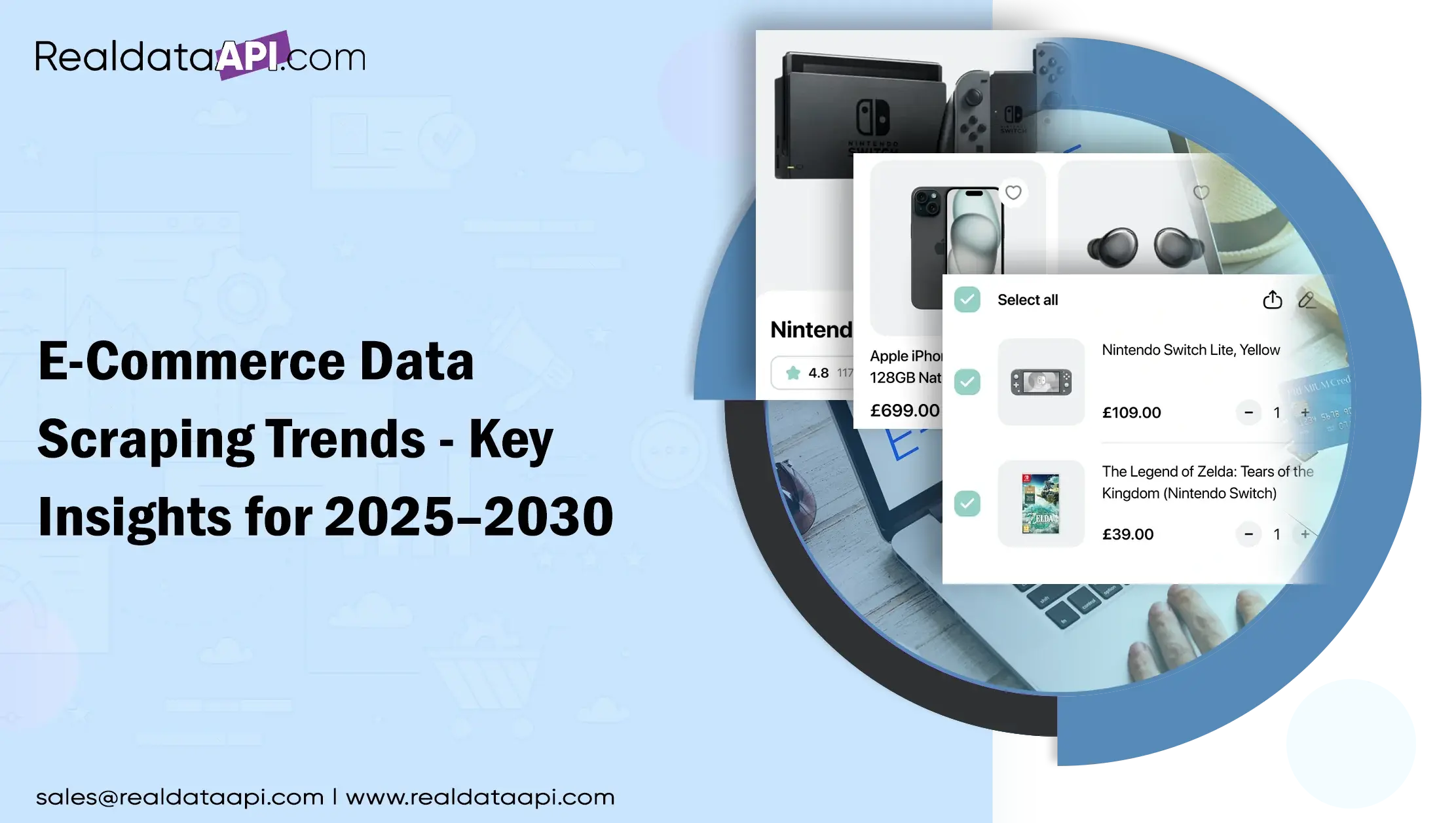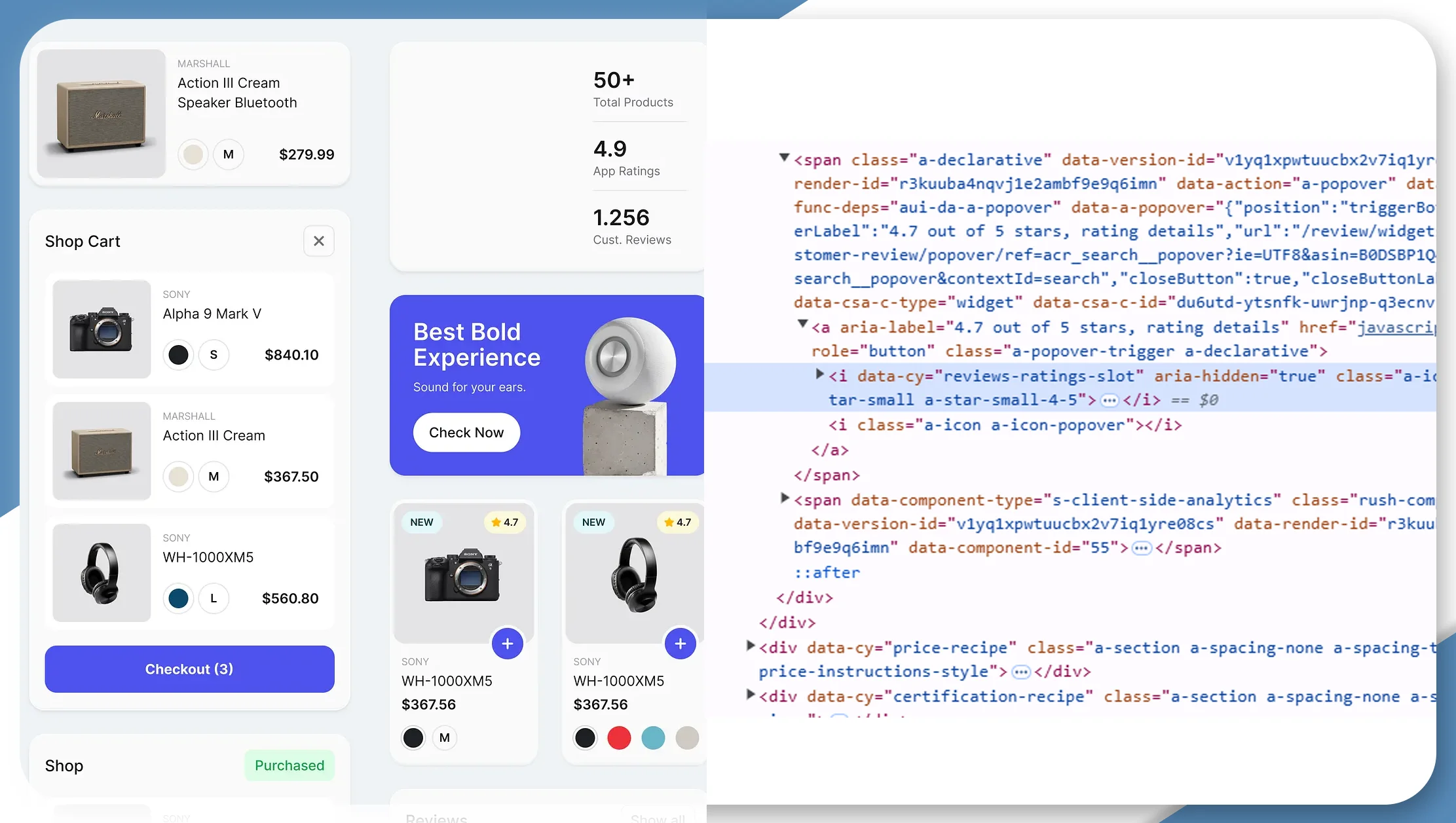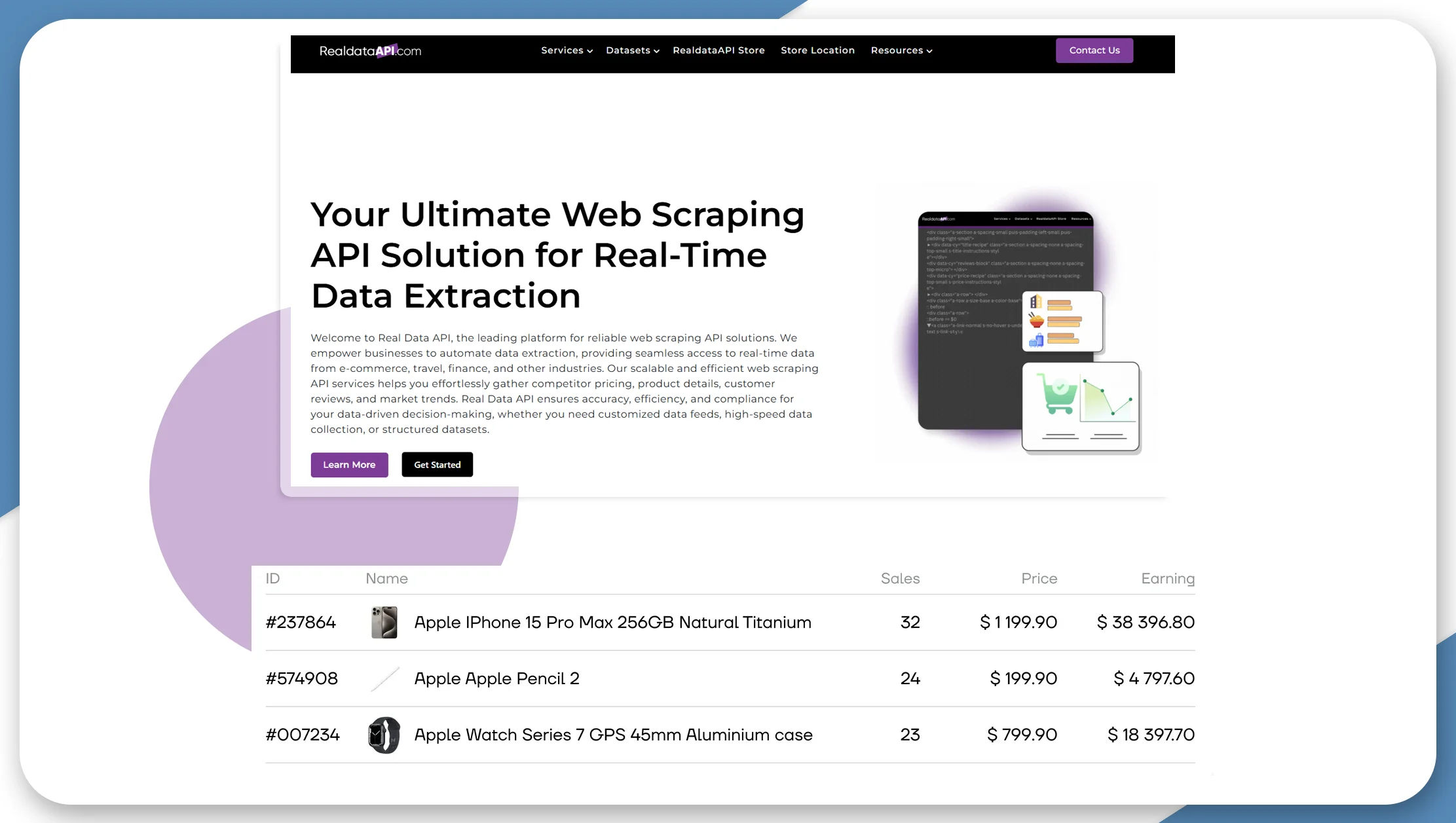.webp)

Introduction
In the ever-evolving landscape of e-commerce, staying ahead of the competition requires businesses to constantly analyze data, track trends, and leverage the latest technologies. One of the most effective ways to gain a competitive edge in e-commerce is through E-Commerce Data Scraping, a practice that allows companies to collect and analyze vast amounts of online data. In this blog, we will explore the E-Commerce Data Scraping Trends that are expected to shape the industry from 2025 to 2030. We will also dive into data analytics trends, E-Commerce API trends 2025, the role of predictive analytics, and the importance of data analytics services.
What is E-Commerce Data Scraping?

E-commerce is an industry that thrives on data. Businesses use customer information, market trends, and competitor data to optimize their strategies, improve customer experiences, and maximize sales. E-Commerce Data Scraping is the process of extracting data from online stores, competitor websites, and other digital platforms. This data is then used to analyze product pricing, customer behavior, inventory levels, and much more. The data can be gathered through web scraping services or E-Commerce Data Scraping API.
By 2025, the global web scraping market is projected to grow significantly, with estimates showing a compound annual growth rate (CAGR) of over 25%. As businesses look to extract valuable insights from large datasets, understanding the key trends in data analytics services will be crucial to staying ahead of the curve.
Key E-Commerce Data Scraping Trends
The e-commerce data scraping landscape is constantly changing, driven by new technologies and consumer demands. Let’s take a look at the key trends in E-Commerce Data Scraping that businesses should pay attention to in the coming years.
Automation of Data Scraping
Automation is one of the most significant trends in E-Commerce Data Scraping. As businesses look for ways to efficiently collect large amounts of data, automated tools and systems have become indispensable. Automated scraping tools are designed to gather data from multiple sources without the need for manual intervention, making the process faster, more reliable, and cost-effective.
Statistical Insight: By 2025, over 70% of businesses involved in e-commerce will utilize automated data scraping tools to gather real-time insights.
| Year | % of Businesses |
|---|---|
| 2025 | 70% |
| 2026 | 75% |
| 2027 | 80% |
| 2028 | 85% |
The growing adoption of AI and machine learning technologies is fueling the rise of automated scraping solutions. These tools are capable of learning from patterns and improving their scraping techniques over time, which increases data accuracy and reduces the risk of errors.
Real-Time Data Scraping
In the fast-paced world of e-commerce, businesses need data that reflects the current market environment. Real-time data scraping allows businesses to continuously monitor competitor pricing, stock levels, and promotional offers, ensuring they remain competitive.
Statistical Insight: By 2026, real-time data scraping in e-commerce will account for 40% of all data scraping operations.
| Year | % of Real-Time Data Scraping |
|---|---|
| 2025 | 35% |
| 2026 | 40% |
| 2027 | 45% |
| 2028 | 50% |
Real-time data scraping also plays a crucial role in optimizing supply chain management. By monitoring product availability in real-time, businesses can adjust their inventories accordingly, preventing overstocking or understocking, and improving their overall efficiency.
Cross-Platform Scraping
E-commerce platforms are no longer confined to a single website. Retailers often sell products through multiple channels, including social media, online marketplaces, and mobile apps. As such, cross-platform scraping is becoming a vital trend in data collection.
This type of scraping enables businesses to gather data from a variety of platforms, providing a comprehensive view of their competitors and market trends. Cross-platform scraping tools are designed to work across different e-commerce platforms and websites, making them more versatile and efficient.
Statistical Insight: By 2027, cross-platform scraping will represent 35% of the total e-commerce data scraping efforts.
| Year | % of Total E-Commerce Data Scraping |
|---|---|
| 2025 | 28% |
| 2026 | 30% |
| 2027 | 35% |
| 2028 | 38% |
Advanced Web Scraping Techniques
As websites become more complex and dynamic, traditional scraping methods are no longer sufficient. Advanced techniques like browser automation, CAPTCHA solving, and headless scraping are becoming increasingly popular.
These advanced scraping methods allow businesses to bypass obstacles such as JavaScript rendering, dynamic content, and CAPTCHA systems, ensuring they can extract data from even the most sophisticated websites.
Statistical Insight: Advanced web scraping techniques are expected to grow by 40% year-over-year between 2025 and 2028.
| Year | % of Growth |
|---|---|
| 2025 | 35% |
| 2026 | 38% |
| 2027 | 40% |
| 2028 | 42% |
E-Commerce Data Scraping and Data Analytics Trends
As e-commerce businesses collect large volumes of data, the next step is to extract meaningful insights from that data. Data analytics trends are key to understanding how to make the most of the data you collect. Let’s explore some of the key trends in data analytics and how they intersect with e-commerce data scraping.
The Role of Predictive Analytics in E-Commerce
Predictive analytics is one of the most powerful tools available to e-commerce businesses today. By analyzing historical data, predictive analytics tools can forecast future trends, such as customer buying behavior, demand for certain products, and inventory levels. This allows businesses to make data-driven decisions and plan for future demand.
Statistical Insight: By 2029, predictive analytics will drive 50% of all e-commerce business decisions.
| Year | % of E-Commerce Decisions Driven |
|---|---|
| 2025 | 42% |
| 2026 | 45% |
| 2027 | 47% |
| 2028 | 50% |
Predictive analytics is powered by machine learning algorithms, which are trained on large datasets to make predictions. E-commerce businesses can use this technology to optimize pricing strategies, personalize marketing campaigns, and improve customer retention.
Integration of AI and Machine Learning in Data Analytics
AI and machine learning are transforming data analytics in e-commerce. These technologies allow businesses to analyze massive amounts of data quickly and accurately. By integrating AI into data scraping tools, e-commerce companies can identify patterns, trends, and insights that were previously difficult to uncover.
Statistical Insight: By 2028, AI and machine learning will account for 60% of all data analytics services in e-commerce.
| Year | % of E-Commerce Data Analytics Driven |
|---|---|
| 2025 | 52% |
| 2026 | 55% |
| 2027 | 58% |
| 2028 | 60% |
AI-powered analytics platforms can help businesses detect fraud, forecast customer behavior, and personalize user experiences based on browsing and purchasing history. As these technologies evolve, their impact on e-commerce will only continue to grow.
E-Commerce API Trends 2025
As businesses continue to rely on data scraping and analytics, E-Commerce APIs are becoming more critical. APIs allow businesses to integrate their e-commerce platforms with external data sources, enabling seamless data exchange.
Increased Adoption of E-Commerce Data Scraping API
The adoption of E-Commerce Data Scraping API is expected to increase dramatically in 2025 and beyond. These APIs provide businesses with a streamlined way to access and collect data from websites and platforms, without the need for complex coding or scraping infrastructure.
Statistical Insight: By 2025, the market for e-commerce APIs will reach $10 billion, with a 20% annual growth rate.
| Year | Market Size of E-Commerce APIs (in billion USD) |
|---|---|
| 2025 | 12 |
| 2026 | 14 |
| 2027 | 16 |
| 2028 | 18 |
E-commerce companies can use E-Commerce Data Scraping APIs to collect information such as product prices, availability, reviews, and ratings. This data is then used to optimize pricing strategies, marketing campaigns, and product assortments.
Security and Compliance in API Usage
As data scraping becomes more prevalent, businesses must ensure they comply with regulations and maintain secure data practices. In 2025, there will be a significant push towards more secure and compliant APIs in the e-commerce space.
Statistical Insight: By 2025, over 65% of e-commerce businesses will prioritize API security and compliance with data privacy regulations.
| Year | % of Businesses Prioritizing API |
|---|---|
| 2025 | 65% |
| 2026 | 70% |
| 2027 | 75% |
| 2028 | 80% |
APIs that adhere to industry standards and regulations will be essential for businesses to ensure data protection and avoid legal issues.
How Real Data API Can Help?

At the heart of these trends is Real Data API, a robust platform designed to provide businesses with accurate and real-time e-commerce data. By utilizing E-Commerce Data Scraping API from Real Data API, businesses can streamline their data collection processes, improve decision-making, and enhance their marketing strategies. Whether you are looking for product pricing, competitor data, or customer insights, Real Data API can help you access the data you need to stay competitive in the marketplace.
Real Data API allows businesses to automate the data collection process, integrate it seamlessly into their platforms, and use powerful analytics tools to derive meaningful insights. With its focus on data accuracy, security, and compliance, Real Data API ensures that your business stays ahead in the data-driven world of e-commerce.
Future Outlook: 2025-2030
The future of E-Commerce Data Scraping looks promising, with continuous advancements in technology and data analytics. From 2025 to 2030, we can expect to see:
- A significant increase in the use of AI and machine learning for data scraping and analytics.
- Further automation of e-commerce data scraping processes.
- A shift towards more sophisticated, cross-platform scraping tools.
- Increased investment in secure and compliant E-Commerce APIs.
Businesses that embrace these trends will be better equipped to navigate the rapidly changing e-commerce landscape and stay ahead of the competition.
Conclusion
The future of e-commerce is closely tied to data, and E-Commerce Data Scraping Trends will continue to play a pivotal role in shaping the industry. As we move towards 2025 and beyond, businesses must embrace the latest data analytics trends, E-Commerce API trends 2025, and advancements in predictive analytics to stay competitive.
With the rise of automation, real-time scraping, and AI-powered analytics, the e-commerce landscape will continue to evolve. To stay ahead, businesses must leverage powerful tools like Real Data API, which can provide accurate, real-time data that drives growth and success.
If you're ready to take your e-commerce business to the next level with real-time data and insights, reach out to Real Data API today! Start leveraging powerful data analytics services and stay ahead of the competition.
Don’t miss out on the latest e-commerce data trends. Get started with Real Data API now and unlock the power of real-time data for your business!













